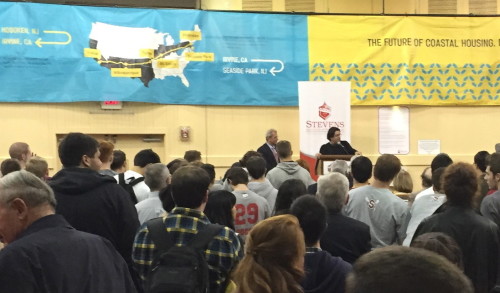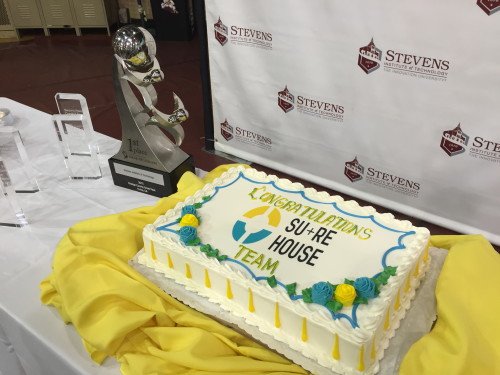
SU+RE DID IT: Stevens Celebrates Overwhelming Victory at 2015 Solar Decathlon
Employing first-hand lessons learned in Hurricane Sandy, the team from Stevens Institute of Technology won top honors at the U.S. Department of Energy Solar Decathlon 2015 at Orange County Great Park in Irvine, California, with their SU+RE House—built around the principles of being “SU”stainable and “RE”silient in the face of natural disaster.
SU+RE House won first place overall, after achieving a total score of 950.685 while taking first place in the categories of architecture, market appeal, communications, appliances, engineering, commuting and home life.
“This competition challenges the best and brightest minds from around the world to create innovative, highly energy-efficient homes that will change how we build,” said U.S. Energy Secretary Ernest Moniz. “These homes will become the new standard in blending affordability, consumer appeal and design with optimal energy production and maximum efficiency.”

Stevens President Nariman Farvardin and Architect/Faculty Advisor John Nastasi address the crowd celebrating the SU+RE victory.
“This incredible victory is the culmination of a two-year journey and a testament to the hard work, commitment and ingenuity of the Stevens Solar Decathlon team,” said Stevens President Nariman Farvardin. “Their participation in this competition embodies the Stevens ethos to leverage science and technology education to confront some of society’s biggest challenges. I could not be more proud of our students and the faculty who guided them to this outcome, and I congratulate them all on this extraordinary achievement.”
“On behalf of the City of Hoboken, I congratulate the students and faculty of the SU+RE House team on their tremendous accomplishment,” said Hoboken Mayor Dawn Zimmer. “Flooding is a century-old challenge for Hoboken, and this project is further demonstration of Stevens’ commitment to our community.”
“This is a monumental feat and our students have much to be proud of,” said John Nastasi, lead faculty advisor on SU+RE House.
The Stevens team focused on developing the SU+RE House to withstand a hurricane while also setting a gold standard for energy sustainability. Built with fiber-composite materials that were repurposed from the boat building industry, the home is designed to waste as little energy expended on heating and cooling as possible. The result is a building armored against extreme weather with a minimal carbon footprint.
Surrounding the home are bi-folding storm shutters, made with a composite foam core and wrapped with fiberglass, installed to shade the home throughout the year and act as the primary defensive barrier to block debris and water during inclement weather. SU+RE House powers itself with clean solar power, and uses 90 percent less energy than its conventional cousins. Inspired by the community support seen in Hoboken post-Sandy, SU+RE House can become a hub of emergency power for surrounding neighborhoods in the aftermath of a storm, charging electrical devices.
SU+RE House was built with tremendous support from sponsors PSE&G. Meanwhile, this year’s competition added an additional challenge by requiring that the homes be built to power a hybrid, non-electric vehicle. Circle BMW in Eatontown, NJ provided a BMWi3 that could run 90 miles off of the power received from SU+RE House.
“This project was about creating a real, livable residence for families in coastal communities who will be hardest hit by the effects of climate change,” said A.J. Elliott, a graduate student in the Stevens Product Architecture and Engineering program and member of the SU+RE House team. “Our design provides a blueprint for the construction of homes that can endure extreme weather and epitomizes the principals of sustainable living.”


 Previous Article
Previous Article Next Article
Next Article Work it Out Fitness Hosting “Ride for a Cause” to Promote Autism Awareness — SUNDAY
Work it Out Fitness Hosting “Ride for a Cause” to Promote Autism Awareness — SUNDAY  Council to Seek Further Input on Hoboken Yard Redevelopment Plan
Council to Seek Further Input on Hoboken Yard Redevelopment Plan  AMAZIN’ AGAIN: Meet the Mets’ Writer/Author Greg Prince at Little City Books — MONDAY
AMAZIN’ AGAIN: Meet the Mets’ Writer/Author Greg Prince at Little City Books — MONDAY  WALKING IT BACK: Hoboken Looks to Revise Draconian Dog Restrictions
WALKING IT BACK: Hoboken Looks to Revise Draconian Dog Restrictions  Hoboken Mayor Ravi Bhalla Takes Role at Law Firm
Hoboken Mayor Ravi Bhalla Takes Role at Law Firm  WALK SAFE HOBOKEN: Police Department Receives Grant for Pedestrian Safety Program
WALK SAFE HOBOKEN: Police Department Receives Grant for Pedestrian Safety Program  Fridays Are For Frank: “I Get a Kick Out of You”
Fridays Are For Frank: “I Get a Kick Out of You”  Adam Wade: The Human Comedy — Hoboken Humorist’s Live Album Climbs the Charts
Adam Wade: The Human Comedy — Hoboken Humorist’s Live Album Climbs the Charts